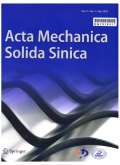- 钛学术文献服务平台 \
- 学术期刊 \
- 基础科学期刊 \
- 力学期刊 \
- 固体力学学报(英文版)期刊 \
AN ASSESSMENT OF THE MESHLESS WEIGHTED LEAST-SQUARE METHOD
AN ASSESSMENT OF THE MESHLESS WEIGHTED LEAST-SQUARE METHOD
基本信息来源于合作网站,原文需代理用户跳转至来源网站获取
摘要:
The meshless weighted least-square (MWLS) method was developed based on the weighted least-square method. The method possesses several advantages, such as high accuracy, high stability and high e?ciency. Moreover, the coe?cient matrix obtained is symmetric and semi- positive de?nite. In this paper, the method is further examined critically. The e?ects of several parameters on the results of MWLS are investigated systematically by using a cantilever beam and an in?nite plate with a central circular hole. The numerical results are compared with those obtained by using the collocation-based meshless method (CBMM) and Galerkin-based meshless method (GBMM). The investigated parameters include the type of approximations, the type of weight functions, the number of neighbors of an evaluation point, as well as the manner in which the neighbors of an evaluation point are determined. This study shows that the displacement accuracy and convergence rate obtained by MWLS is comparable to that of the GBMM while the stress accuracy and convergence rate yielded by MWLS is even higher than that of GBMM. Furthermore, MWLS is much more e?cient than GBMM. This study also shows that the instability of CBMM is mainly due to the neglect of the equi- librium residuals at boundary nodes. In MWLS, the residuals of all the governing equations are minimized in a weighted least-square sense.

推荐文章
A re-assessment of nickel-doping method in iron isotope analysis on rock samples using multi-collect
Fe isotope
Ni-doping
Stable isotope
Precision and accuracy
Mass bias correction
Pseudo-high mass resolution
基于Chi-square检验的分布式网络入侵检测系统
入侵检测
分布式
Chi-square检验
Chi-square Distance在协议异常检测中的应用
入侵检测
协议异常检测
马尔可夫链
马尔可夫过程
内容分析
关键词云
关键词热度
相关文献总数
(/次)
(/年)
文献信息
| 篇名 | AN ASSESSMENT OF THE MESHLESS WEIGHTED LEAST-SQUARE METHOD | ||
| 来源期刊 | 固体力学学报(英文版) | 学科 | 工学 |
| 关键词 | |||
| 年,卷(期) | 2004,(3) | 所属期刊栏目 | |
| 研究方向 | 页码范围 | 270-282 | |
| 页数 | 13页 | 分类号 | TB11 |
| 字数 | 语种 | 中文 | |
| DOI | |||
五维指标
引文网络
引文网络
二级参考文献 (0)
共引文献 (0)
参考文献 (0)
节点文献
引证文献 (0)
同被引文献 (0)
二级引证文献 (0)
2004(0)
- 参考文献(0)
- 二级参考文献(0)
- 引证文献(0)
- 二级引证文献(0)
引文网络交叉学科
相关学者/机构
期刊影响力
固体力学学报(英文版)
主办单位:
中国力学学会
出版周期:
双月刊
ISSN:
0894-9166
CN:
42-1121/O3
开本:
16开
出版地:
武汉市珞瑜路1037号
邮发代号:
创刊时间:
1987
语种:
eng
出版文献量(篇)
1143
总下载数(次)
0
总被引数(次)
3267
期刊文献
相关文献
推荐文献
- 期刊分类
- 期刊(年)
- 期刊(期)
- 期刊推荐
力学
化学
地球物理学
地质学
基础科学综合
大学学报
天文学
天文学、地球科学
数学
气象学
海洋学
物理学
生物学
生物科学
自然地理学和测绘学
自然科学总论
自然科学理论与方法
资源科学
非线性科学与系统科学
固体力学学报(英文版)2022
固体力学学报(英文版)2021
固体力学学报(英文版)2020
固体力学学报(英文版)2019
固体力学学报(英文版)2018
固体力学学报(英文版)2017
固体力学学报(英文版)2016
固体力学学报(英文版)2015
固体力学学报(英文版)2014
固体力学学报(英文版)2013
固体力学学报(英文版)2012
固体力学学报(英文版)2011
固体力学学报(英文版)2010
固体力学学报(英文版)2009
固体力学学报(英文版)2008
固体力学学报(英文版)2007
固体力学学报(英文版)2006
固体力学学报(英文版)2005
固体力学学报(英文版)2004
固体力学学报(英文版)2003
固体力学学报(英文版)2001
固体力学学报(英文版)2000

 免费查重
免费查重










